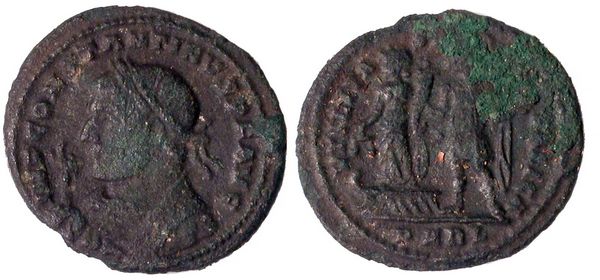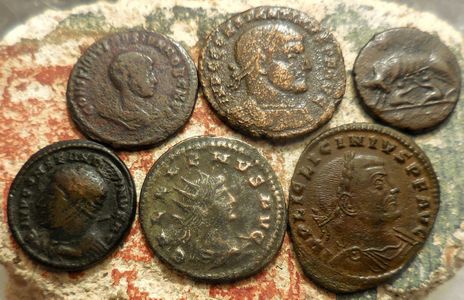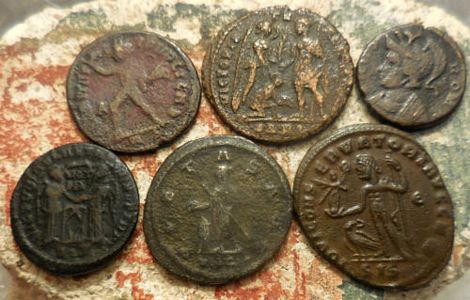
A previously unrecorded reverse for Constantine I
Constantine I
A.D. 313
21mm 3.7gm
IMP C
CONSTANTINVS P F AVG; laureate and cuirassed bust right.
VICTORIA [AETERNA
AVGG NN]; Emperor on right, in military dress, holding
spear, receiving palm branch from Victory; kneeling figure
between them [holding offering].
In exergue SARL
RIC VII Arles —
The coin pictured above is a previously
unknown reverse type for Constantine I. For people
interested in Constantine and his coinage, this is an
exciting discovery. New types do not appear very often and,
surprisingly, this example turned up on eBay. This coin was sold
as part of a group of coins on eBay in January of 2017 for
$460.55. Below are pictures of the obverse and reverse of
the coins from the listing.
Seller’s description
"Lot of 6 Obvious and Very Fine Roman Coins, The Licinus is 25
mm for Reference."
Though this reverse type is unrecorded
for Constantine, the iconography is very similar to coins
minted by Maxentius from the mint of Ostia. Below are some
pictures of Ostian coinage from Maxentius for comparison.
Image from Vincent Drost, Le monnayage de Maxence (306-312 après J.-C.)
The mint of Ostia was closed in A.D. 312 after
Constantine defeated Maxentius. Shortly after, the Ostia
mint was then transferred to Arles, sometime in early- mid
A.D. 313. The new Arles mint even struck two coins to mark
the occasion of the transfer of the Ostia mint to Arles --
VTILITAS PVBLICA (RIC VII Arles 49- 51) and PROVIDENTIAE
AVGG (RIC VII Arles 30- 32). The VTILITAS reverse depicts
the mint leaving Ostia, as the prow is pointed away from the
soldier, so it is departing; while the PROVIDENTIAE type
depicts the mint arriving at Arles, since the
personification of Arles is greeting it and the prow shows
that it is arriving. Note the similar styles of the reverse
imagery with the Ostian coinage pictured above.
 |
|
| VTILITAS PVBLICA - mint leaving Ostia |
PROVIDENTIAE AVGG- mint arriving at
Arles |
Since
the style is similar to Ostia coinage, it makes sense that
this coin was issued shortly after the Arles mint opened.
The problem is the reverse legend is not entirely legible.
The VICTORIA part is clear, but the rest is not so
evident. Below is another coin from Ostia. Note how the
depiction of the emperor closely mirrors the VICTORIA from
Arles. The reverse legend of the Ostian coin is VICTORIA
AET AVGGG NNN. Three emperors are recognized on this coin-
Constantine I, Licinius I and Maximinus II. Arles did not
issue any coins in the name of Maximinus II, so the
reverse from Arles would be something like AVGG NN.
Perhaps the kneeling figure on the reverse of the VICTORIA
coin from Arles represents Maximinus II.

VICTORIA AET AVGGG NNN Ostia mint
Arles
did not issue any coins in the name of Maximinus II, so it
must have begun striking coins circa April 313, after
hostilities began between Maximinus II and Licinius I.
Accordingly, the reverse from Arles would only name two
Emperors-- like AVGG NN. Since it is a Victory reverse and
seems to reference some type of victory, It is tempting to
associate the kneeling figure on the reverse of the VICTORIA
coin from Arles with Maximinus II.
The reverse legend is just not
certain, VICTORIA AETERNA AVGG NN (or some variation) would
seem obvious based on the Ostia coin; but the legend after
VICTORIA is not clear. There are several possibilities that
make sense, which of course could include any variations of
said legends, most likely plural for two emperors, coupled
with AVGG, AVGG N, AVGG NN, etcetera. It seems the second
letter in the word after VICTORIA is an "E" which helps a
little, so obvious possibilities include VICTORIA AE[TERNA],
VICTORIA PE[RPETVA] or VICTORIA FE[LICITAS].
This coin
is now back in Arles at the Arles
Museum of Antiquity. Hopefully it will be on display for
the public soon.
References
Roman Imperial
Coinage VI: Diocletian to Maximinus. London: Spink &
Son, 2003.
Roman Imperial
Coinage VII: Constantine and Licinius. London: Spink
& Son, 1966.
Drost, Vincent. Le
monnayage de Maxence (306-312 après J.-C.)
Ferrando, Philippe.
L'atelier
monétaire d'Arles de Constantin Le Grand a Romulus Augustule
(313-476)

